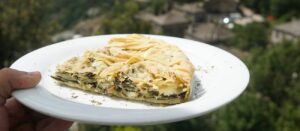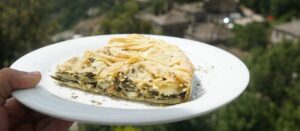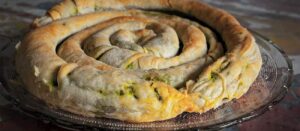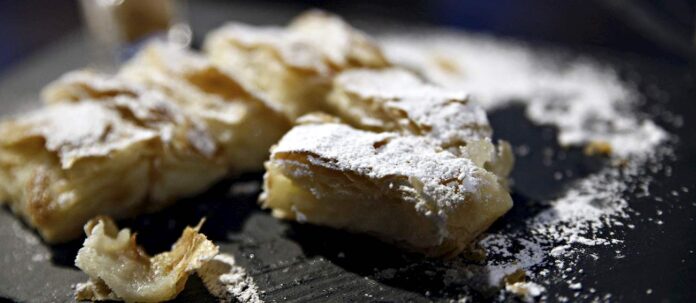TasteAtlas food rankings are based on the ratings of the TasteAtlas audience, with a series of mechanisms that recognize real users and that ignore bot, nationalist or local patriotic ratings, and give additional value to the ratings of users that the system recognizes as knowledgeable. For the “Top 11 Greek Phyllo Pastries” list until February 06, 2024, 1,272 ratings were recorded, of which 750 were recognized by the system as legitimate. TasteAtlas Rankings should not be seen as the final global conclusion about food. Their purpose is to promote excellent local foods, instill pride in traditional dishes, and arouse curiosity about dishes you haven’t tried.

01 SWEET PASTRY / Trigona panoramatos / THESSALONIKI, GREECE
Trigona panoramatos is a traditional Greek sweet pastry originating from the outskirts of Thessaloniki. These crispy and buttery triangular (cone-shaped) phyllo pastries are typically soaked in syrup and filled with creamy custard. The custard is usually made with a combination of egg yolks, flour, butter, milk, sugar, vanilla, and heavy cream.
The phyllo triangles are baked until golden brown, dipped in cold syrup consisting of sugar and water, and then filled with the chilled custard. Trigona is often garnished with chopped nuts before consumption.

02 SWEET PASTRY / Bougatsa / SÉRRES, GREECE
Bougatsa is a traditional, rustic Greek pie consisting of a phyllo pastry layered with a filling of semolina custard, although there are variations with minced meat or cheese. The name of the dish is a derivation of the Ottoman word pogatsa, denoting a pie filled with cheese.
Bougatsa has origins from the Byzantine period, when Constantinople was Greek, and it began as a dough that was stuffed with numerous sweet and savory fillings. Over time, bougatsa evolved to incorporate a thinly rolled, hand-made phyllo pastry. As many Turkish immigrants settled in Northen Greece, bougatsa became a specialty of Serres and Thessaloniki.

03 SAVORY PASTRY / Tiropita
Tiropita is a popular Greek snack consisting of sheets of phyllo dough that are filled with a combination of cheese (usually feta) and eggs. The dish is typically wrapped in triangular pieces and brushed with melted butter before baking. This tasty pastry is found in almost every Greek bakery, although it is commonly served as an appetizer, when it is accompanied by numerous dips on the side.
There are several theories about its origin, but most link the dish with either Byzantine, Roman, or Turkish cuisine. Tiropita is mostly consumed in the mid-morning in Greece, since breakfast is usually reserved only for bread with butter and a cup of coffee.

04 SWEET PASTRY /Galaktoboureko
This traditional Greek dessert consists of numerous phyllo sheets that are sprinkled with melted butter and coupled with a light semolina custard. When baked and well-chilled, the pastry is traditionally doused in the orange spiced, sugary syrup, allowing the layers to absorb the flavors and transform galaktoboureko into a soft, velvety treat.
This Greek classic is commonly found in pastry shops and traditional taverns across the country.
05 SAVORY PASTRY / Skopelitiki tiropita / SKOPELOS, GREECE
Skopelitiki tiropita is a type of Greek cheese-filled pastry (tiropita) that has been traditionally prepared on the island of Skopelos. The pastry uses local goat milk feta cheese and olive oil from the area of Skopelos for the filling, while the dough typically consists of all-purpose flour, olive oil, water, salt, and vinegar.
Once it reaches a soft and elastic consistency, the phyllo dough is rolled out, drizzled with olive oil, sprinkled with crumbled feta cheese, and shaped into a spiral. The spiral-shaped pastry is then usually deep-fried in hot oil until golden brown and crispy on both sides, although it can also be baked in an oven.

06 SAVORY PASTRY / Spanakopita
Spanakopita is a Greek spinach pie consisting of a buttery, flaky phyllo pastry with a filling of cooked spinach, lemon juice, feta cheese, and sometimes dill. It can be served either as a small snack, an appetizer, or a light main course. Due to a farming tradition of handheld foods, the pies were originally invented for the field workers who would carry them in their pockets and consume them while working.
Although spanakopita has humble beginnings, it has risen to greater gastronomic heights, so today it can be found in most Greek diners, taverns, and upscale restaurants. It is likely that the dish originated 400 years ago, during the Turkish occupation of Greece, since a Turkish dish called ispanaki is almost identical in presentation.

07 SAVORY PASTRY / Hortopita
Hortopita, from the Greek words horta, meaning wild greens (also a general term for greens in Greek), and pita, which means pie, is a traditional Greek savory pastry that’s filled with a variety of wild or cultivated greens.
The pastry is typically made with phyllo dough, while apart from the greens, the filling usually contains aromatic herbs, crumbled cheese (such as feta cheese), and sometimes eggs. These pastries can be made with any combination of greens and herbs; therefore, there’s no set recipe for hortopita.

08 SWEET PASTRY / Hamalia /SKOPELOS, GREECE
Hamalia is a traditional dessert prepared on the Greek islands of Alonnisos and Skopelos. It is a type of sweet pastry consisting of thin Greek phyllo crust filled with a mixture of ground almonds, honey, cinnamon, and nutmeg. The filling is flavored with lemon and orange juice or rose water.
These pastries are shaped into small triangles, and once baked, they’re typically served dusted with powdered sugar. On Alonnisos and Skopelos, people traditionally offer this sweet specialty at special occasions such as weddings and engagements, which is how the pastry earned its other name, the dessert of joy.
09 SWEET PASTRY / Masourakia /CHIOS, GREECE
Masourakia is a traditional Greek dessert hailing from the island of Chios. It consists of buttered phyllo kroustas (thin Greek pastry) that’s rolled around a filling of mastic-flavored ypovríchio (a Greek sweet, also known as submarine), ground almonds, egg whites, and mandarin or lemon zest.
The pastry rolls are baked until crispy and lightly browned, and they are then either dusted with powdered sugar or soaked in flavored syrup before being coated with nuts (usually ground almonds) and sprinkled with powdered sugar on top. These sweet, crispy rolled pastries are commonly prepared for Christmas.

10 SWEET PASTRY / Samsades / LEMNOS, GREECE
Samsades is a traditional Greek dessert consisting of phyllo dough that’s rolled around a filling of nuts, baked, and then drenched in sugar or honey syrup, local thyme honey, or grape must (petimezi). The filling typically consists of almonds and sesame seeds, although walnuts are also occasionally added to the combination, and it’s often flavored with cinnamon, cloves, and almond flavoring or floral water.
Similar to baklava, the dessert is usually made with a type of thin Greek pastry called phyllo kroustas, and it is one of the traditional desserts prepared on the island of Lemnos and Laconia. These sweet pastries are commonly enjoyed alongside a cup of coffee or tea, and they’re typically made around New Year’s and Christmas, although nowadays, they can be found year-round in bakeries.

11 SAVORY PASTRY / Tsouknidopita / GREECE
This traditional Greek pie consists of cooked or sautéed nettles that are placed between two layers of phyllo pastry. Along with nettles, the filling can also incorporate herbs, onions, and crumbled feta cheese. Tsouknidopita is best served freshly prepared, while it is still warm and crispy and can be enjoyed as an appetizer, snack, or a light main course.














